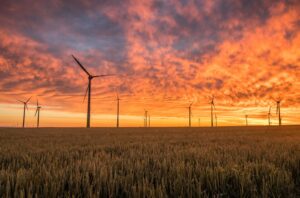The future of renewable energy in Wales is up in the air, with significant policy differences between the UK and Welsh governments, both of which have regulatory responsibilities.
In general terms, the UK Government is interested in offshore schemes while the Welsh Government favours projects that are onshore.
A cynic would suggest this stems from the split between their responsibilities.
Onshore wind projects come under the Welsh Government. Small projects of under 10 megawatts (MW) are decided on at local authority level, while those over 10MW go through the DNS (Developments of National Significance) planning process.
Onshore projects may be built on farmland or private land with the approval of the owners, or on forestry land owned by the Welsh Government and managed by Natural Resources Wales (NRW).
Following the introduction of the DNS regime, the Wales Act 2017 devolved some further consenting powers to the Welsh Government, including those relating to energy generating stations.
Consenting powers for stations, including onshore wind, with a capacity of up to and including 350MW onshore and in Welsh waters – an inshore area out to approximately 12 nautical miles from Welsh shores – are now devolved.
Offshore wind and marine energy over 12 nautical miles from Welsh shores is not devolved, with the new generation of offshore wind projects tending to be more than 20 kilometres offshore and over 350MW.
The responsibility for offshore wind projects is split between the Crown Estate, which has to lease the seabed, and the UK Government for approval and grid connection.
National Grid
Ultimately no project, on or offshore, can go ahead without agreement in principle from the National Grid for a connection, unless what is being proposed is a small “closed loop” system, for example a farm that has its own generator that powers its own buildings and is not connected to the grid.
As it states on its website, ‘since 1928, the Campaign for the Protection of Rural Wales has been standing up for the people and places of rural Wales and protecting our unique landscapes’.
The charity believes Wales is at a crossroads, and that landscapes could be ruined unnecessarily unless there is more joined-up thinking about how climate targets should be achieved and renewable energy delivered.
Currently Wales produces 30 TWH (terawatt hours or one million megawatt hours) of energy while using only 14 TWH. However, demand is estimated to increase to between 35-45 TWH by 2050.
According to an FOI disclosure by NRW, 1,938,400 trees had been cut down on Welsh Government-owned land for the construction of onshore wind energy in Wales by 2020. More trees were cut down on private land or commons.
The industry standard for concrete needed for wind turbines is 220-370 tonnes per MW of installed wind power. Wales had, in 2020, 1,273 MW installed, meaning – on average – over 400,000 tonnes of concrete has been poured into our countryside. This does not include foundations needed for solar or energy infrastructure such as transmission cables or substations so is likely to be much higher.
CPRW argues that Wales could produce twice the energy it needs from offshore wind alone. Proposals for far offshore wind power projects in the Irish and Celtic Sea combined could generate at least 100 TWH of energy, on the basis of recorded average wind speeds,
Even with the estimated increase to 45 TWH of energy demand by 2050, these offshore wind proposals would still produce more than twice what we require, without including existing energy production.
Not viable
Ross Evans, CPRW’s public and community affairs manager, said: ‘So why are we sacrificing our countryside when we don’t need to?
‘The Welsh Government’s energy policy document, Future Wales, was last updated in 2020, and a lot has changed since then. Offshore wind is now not just viable, it is comparatively as cheap as onshore wind.
‘CPRW are seeking political support for a moratorium on all new onshore wind development that are not community-led until Future Wales 2040 is updated, and integrated with the Wales Marine Policy, to recognise the role that offshore wind proposals will have in getting Wales to reach net zero.
‘This position would not only tick the renewables box, but also that of protecting the Welsh Countryside, farmland, and safeguard tourism in Wales.
‘The Welsh Government cannot meet its targets without offshore wind, and could meet them with only offshore wind, yet still has no holistic plan for renewable energy. The thought process is that, if offshore wind is included in Future Wales 2040 and the Welsh Government’s renewables targets, it would make the argument for more onshore wind redundant.’
Mr Evans said that if the two freeports announced for Wales at Anglesey and Milford Haven/ Aberavon were used correctly, they could be the catalyst for a burgeoning industry and centre of excellence for offshore wind.
He said: ‘Wales will have lots of offshore wind. Let’s have it now, not later. Freeports will not only regenerate ports but facilitate the growth in offshore wind.
‘The very simple fact is that Wales will have huge offshore wind – as will Scotland and England – as it’s the most cost-effective way of reaching net zero. Onshore and solar will only ever ‘make up the numbers’ and should be used that way if necessary. If we have run out of offshore energy production by 2045 and we’re still not there (at net zero), then build onshore. Let’s not do things backwards!
‘The Welsh Government’s energy policy document, Future Wales, was last updated in 2020. At a fringe event on offshore wind at the recent Welsh Labour Conference, in front of a room full of developers, the Minister for Climate Change Julie James admitted to CPRW that offshore wind is not currently included in Future Wales 2040 and that the document hadn’t been updated in three years.
Living document
When questioned further on how we can get offshore included in Future Wales and the Welsh Government’s renewable energy targets, Ms James responded that it was a ‘living document’. I would suggest that it has not done much living in the last three years.
‘The Future Wales policy document only covers terrestrial policy, and needs to be integrated with the Wales National Marine Plan into a single updated set of targets. Without offshore wind being incorporated into Future Wales 2040, CPRW feels that the full potential of offshore wind is not being taken into account.’
CPRW also has concerns about the way the DNS system is operating in Wales.
Mr Evans said: ‘The system was introduced to make planning applications quicker. Covering all devolved power sources over 10MW, the DNS process reduces local authorities to observers, no longer being able to scrutinise proposals, along with the rest of us.
‘Once submitted a proposal going through the DNS system will have a judgement made by Planning and Environment Decisions Wales (PEDW) which then makes a determination for the Minister to consider. It is not clear if the public will get to know the decision made by PEDW, only the final outcome. CPRW feels this creates a deficit of democracy.
‘The DNS website is hard to navigate, impossible to link to individual projects and rarely updated – there are projects on there listed as ‘under consideration’ that were turned down months ago.
‘In recent meetings with MSs and MPs, CPRW has been shocked by how many people have no idea of what the DNS process is, let alone the amount and scale of proposals going through it.’
CPRW has thrown down the gauntlet in a very direct way, which is all to the good.
In the context of renewable energy it’s surely time to move on from insubstantial rhetoric and dithering to confident decision-making in the interests of our nation and the planet.
This article was originally published on Nation.Cymru

















Leave a Reply